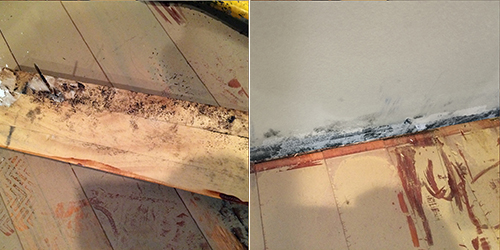We've discovered this post involving Common Causes of Water Damage in a Bathroom down the page on the net and accepted it made perfect sense to talk about it with you on my blog.

The shower room is extremely susceptible for wet build-up as well as possible water damage as a result of the frequent use of water in it. This post supplies simple evaluation methods to aid detecting water damage dangers.
The constant use of water in the restroom makes it very vulnerable for moist build-up and also possible water damage. By examining it on a regular basis, you can minimize water relevant damages.
The following set of assessments is simple to execute and also should be done once in every three months in order to keep your shower room healthy and also to stop potential water damages caused by the tub, the shower, pipe joints as well as plumbing, sinks, cupboards, and also the commode
Do not forget executing these inspections and be comprehensive while performing them. Bear in mind that these easy evaluations can save you a lot of money by offering early indicators for water damage
Sinks as well as Cabinets
Sinks as well as cupboards are subjected to moisture and humidity daily and are frequently overlooked. Inspect regularly under the sink and on the countertop over it. Fix any kind of drip in the catch as it may suggest drain problems. Check out the sink, slow-moving draining pipelines might suggest a blocked drain. Change sink seals if they are fractured or loosened.
Tub and Shower
The shower and bath tub call for unique interest and upkeep. Examine the ceramic tiles as well as replace if fractured. See to it that there is no missing out on grout between the floor tiles. Check as well as replace fractured caulking at joints where the wall surfaces satisfy the floor or the bath tub. Blocked drains and pipes problems will certainly avoid the bathtub from drying out as well as may show serious troubles below the bathtub. Seek advice from a specialist right away to prevent architectural damage. Pay attention to stainings or soft areas around the bathtub wall surfaces as they may show an internal leakage.
Plumbing
Signs for water damage are tough to discover since a lot of pipes are mounted inside the walls.
Pay unique interest to flooring and also walls dampness and discolorations as they may show an undetectable plumbing problem. Inspect moisture degrees in adjoining spaces as well.
The Commode
The toilet is a prone water junction. Examine the water lines and look for leaks around the bathroom seat, in the hose, as well as under the water tank. If you discover any indications of dampness on the floor around the commode, check for leakages in the toilet rim as well as container seals.
Understand that hanging commode bowl deodorants raises the possibilities for obstructions.
TIPS TO PREVENT WATER DAMAGE IN THE BATHROOM
The average household uses approximately 80-100 gallons of water per person per day. For a family of 4, that's almost 2,500 gallons of water a week! The largest portion of this consumption comes from bathroom use. Flushing the toilet uses the most water, followed by taking a shower or bath. With that much water running through the home, water damage in the bathroom is bound to happen. Knowing how to spot signs of a water leak is essential to preventing long-term damage. This guide provides you with tips to reduce the impact of water damage on your bathroom.
CAUSES OF BATHROOM WATER DAMAGE
Pipe breaks are the most common cause of water damage we see in our daily jobs. The age of a pipe plays a large role in a pipe break as well as corrosion. Over time, the metal begins to break down, allowing water to escape. Frozen pipe breaks are also a concern in the winter months. Toilet overflows caused by paper products or children flushing inappropriate items. Degraded caulking around the toilet or bathtub can allow water seepage, sometimes behind the fixture, into the subfloor or walls. Condensation forms when the water in a pipe is cooler than the air temperature. Beads of water form on the exterior of the pipes, sometimes so much so that the water begins to drip and pool below. Sink or shower backups created by poor drainage. HOW TO PREVENT WATER DAMAGE IN YOUR BATHROOM
Inspect your toilet supply line for worn or frayed hoses and replace them as needed. Winterize your plumbing to prevent a frozen pipe break. Use vent fans to prevent condensation that can lead to mold growth. Routinely check and replace degraded caulking around your toilet or bathtub. Increase the temperature in your toilet tank and insulate your pipes during the warm summer months to keep condensation from forming. Use child safety locks on the toilets. Flush only toilet paper. "Flushable" wet wipes are actually not good for your plumbing system. Additionally, feminine hygiene products should not be flushed. Prevent water from escaping the tub or shower. Make sure shower curtains are in good condition. Inspect shower doors and replace the seal strip if necessary. Wipe up any water that accumulates on the floor and use bath mats. Water left to sit can cause damage to the tiles and flooring. Refrain from using bath products containing heavy oils to avoid a clogged drain.

Hopefully you enjoyed our piece on How to Repair and Prevent Bathroom Water Damage. Thanks for taking time to read our post. If you please take the time to distribute this page if you liked it. Thank you for your time. Visit again soon.
Set An Appointment